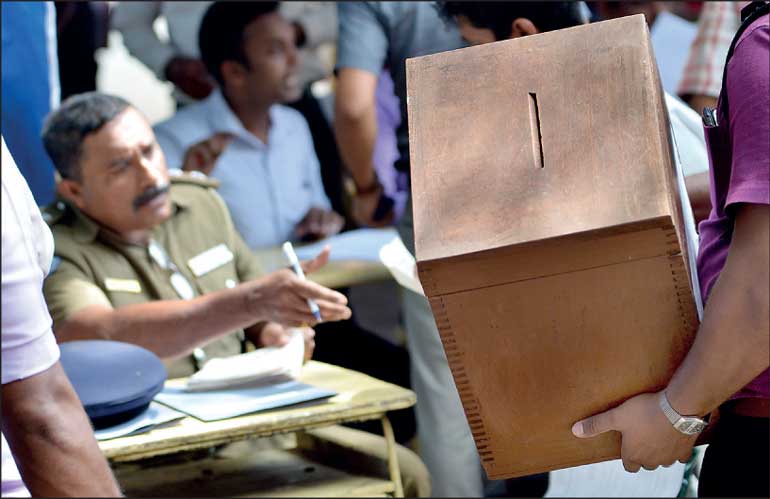Sunday Apr 20, 2025
Sunday Apr 20, 2025
Saturday, 14 September 2024 00:10 - - {{hitsCtrl.values.hits}}

It may be important to pay attention to the second and third preferences in the current Presidential election, which seems to be a three-way battle
– Pic by Shehan Gunasekara
 Presidential elections of most major democracies are held using two-round systems. It is a more democratic variant of the one-round first-past-the-post systems. Even in a two-round system, if a candidate gets more than 50% of the votes in the first round, there is no need for a second round. If no one gets more than 50%, only the first and second candidates will qualify for the second round.
Presidential elections of most major democracies are held using two-round systems. It is a more democratic variant of the one-round first-past-the-post systems. Even in a two-round system, if a candidate gets more than 50% of the votes in the first round, there is no need for a second round. If no one gets more than 50%, only the first and second candidates will qualify for the second round.
Sri Lanka’s presidential election system is a unique one. It seems to be a composite of three systems that are currently used internationally to make the first-past-the-post systems more democratic. The three methods are – Supplementary Vote, Ranked Choice and Two-Round methods. For now, I think it’s more practical for us to think of our system as a variant of a two-round system.
If you look at the presidential election system given to us by Article 92 of the Constitution, it gives you a chance to participate in a second round of voting on the same ballot paper by giving you the opportunity to mark a second and third preference. Here, if the candidate of your choice did not make it to first or second places in the first round but you had given your second preference to one of the two leading candidates, then your second preference will be considered as a valid vote received by that relevant candidate and added to his/her pile in the second round of counting. Then your vote will not be wasted, and you will have the ability to influence the election of your second preferred candidate. If you don’t use the second or third preference, you would be also losing the chance to prevent a candidate you don’t like from winning.
Although marking a second and third preferences has not been a practice so far, it may be important to pay attention to the second and third preferences in the current Presidential election, which seems to be a three-way battle.
In fact, the second preference in Sri Lanka’s presidential election is your right to vote for a second round. A third preference extends that right, but due to time constraints the discussion is limited to the importance of the second preference.
Two-round systems from around the world
For some real-life examples of two-round systems at work, let us consider the four recent presidential elections held in Indonesia, France, Argentina and Peru.
In the Indonesian elections held in 2024, Prabowo Subianto won 58% of the votes in the first round and came to power without the need for a second round.
In the first round of the 2022 French presidential election, Macron and Le Pen came first and second with 27.9% and 23.2% of the vote respectively, and in the 2023 Argentine presidential election, Milieu and Massa got 36% and 30% of the vote respectively. But in the second round, France’s Macron and Argentina’s Milieu showed decisive victories with 59% and 56% respectively, because they received support in the second round from a segment that did not vote for them in the first round.
However, in two-round systems the second round is more likely to reaffirm the winner of the first round, but ChatGPT, gives two examples where second round has reversed the result of the first round. It had apparently happened in France in 1994 and in Peru in 1990.
The chances of such a thing happening in Sri Lanka’s Presidential election this year are less because the use of the second preference is something unfamiliar to our voters and the political parties have not advocated such.
But if there is a need to count a second preference and the original result is changed as a result, there should be no doubt or fear about the validity of that result. My answer to someone who asked whether a second preference should be given the same weight as a first preference, my answer was “If no one gets more than 50% in the first round then your second preference is your right to participate in the second round. If your first preference candidate comes in first or second and qualifies for the second round, your vote has already been counted. If your first preference candidate did not qualify for the final round, it is fair and logical to take your second preference in the first round as your first preference in the second round.”
As I mentioned earlier, this electoral system used for Sri Lanka’s presidential election is a unique one that does not exactly match international classifications. For example, in the Supplementary voting system, the voter gets to mark a first preference and a supplementary preference. Only the first two candidates qualify to benefit from supplementary votes cast for them in the ballot papers of other candidates. Our system follows the Supplementary method in terms of counting the results, but it is closer to the Ranked choice method in that voters are able to list their preferences as 1, 2, 3. But our system is not a ranked choice system because in that system not only the first two but all candidates except the last have an opportunity to have some or all second or third preferences cast for them in the ballot papers of other candidates.
See https://www.electoral-reform.org.uk/voting-systems/ for more information. In the aftermath of the election on 21 September we might be able evaluate our method with more real-life data.
(The writer can be contacted via [email protected].)
Discover Kapruka, the leading online shopping platform in Sri Lanka, where you can conveniently send Gifts and Flowers to your loved ones for any event including Valentine ’s Day. Explore a wide range of popular Shopping Categories on Kapruka, including Toys, Groceries, Electronics, Birthday Cakes, Fruits, Chocolates, Flower Bouquets, Clothing, Watches, Lingerie, Gift Sets and Jewellery. Also if you’re interested in selling with Kapruka, Partner Central by Kapruka is the best solution to start with. Moreover, through Kapruka Global Shop, you can also enjoy the convenience of purchasing products from renowned platforms like Amazon and eBay and have them delivered to Sri Lanka.
Discover Kapruka, the leading online shopping platform in Sri Lanka, where you can conveniently send Gifts and Flowers to your loved ones for any event including Valentine ’s Day. Explore a wide range of popular Shopping Categories on Kapruka, including Toys, Groceries, Electronics, Birthday Cakes, Fruits, Chocolates, Flower Bouquets, Clothing, Watches, Lingerie, Gift Sets and Jewellery. Also if you’re interested in selling with Kapruka, Partner Central by Kapruka is the best solution to start with. Moreover, through Kapruka Global Shop, you can also enjoy the convenience of purchasing products from renowned platforms like Amazon and eBay and have them delivered to Sri Lanka.